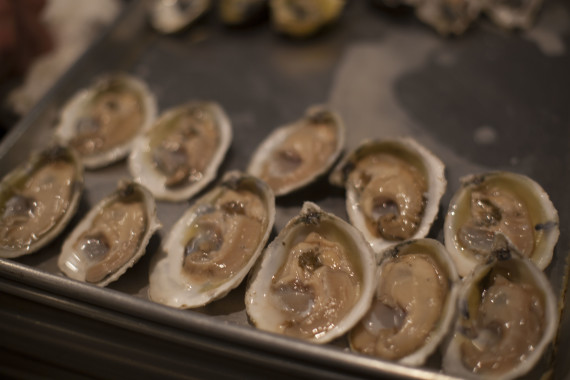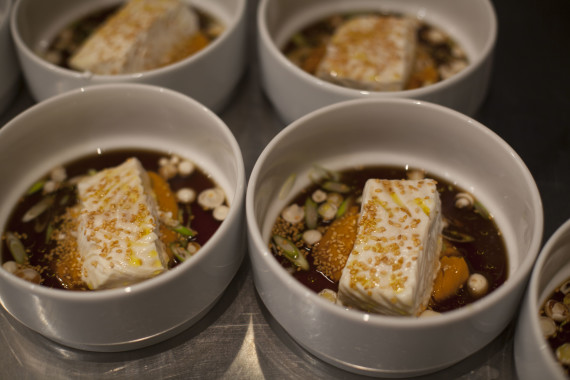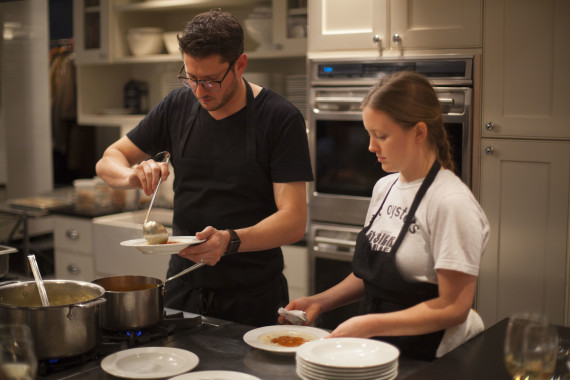Thursday night we had a dinner fit for any true seafood lover from the crew at Oyster House. To start, Chef Aaron Gottesman wooed our guests with a sampling of east coast and west coast oysters while third generation owner Sam Mink provided background on all things oysters. From the difference between east and west coast varieties, the nutritional benefits they provide, and their growth cycle, Sam’s knowledge of oysters is extensive and impressive. Read on to learn more and see what else Aaron cooked up for this seafood feast!
Since 1947 the Mink family has been serving up oysters and fresh seafood in Philadelphia. Being born into an oyster loving family, Sam is well versed in the bivalve biz. Sam explained to our guests that although there are over 150 varieties of oysters sold and harvested in America, they are all from five species. The flavor profile of each depends on where the oysters come from. Since they are filter feeders, mollusks pick up unique tastes based on the temperature, salinity, and algae level of the body of water they live in. Oysters can filter up to 50 gallons of water a day! All that filter feeding helps them grow, and according to Sam after about 2-3 years, they will mature to market size. Water temperature greatly affects their growth. For example, once the water temperature drops to below 50 degrees Fahrenheit, the oysters will become dormant.
Our class started off with a side by side tasting of Sweet Amalia (east coast) and Fanny Bay (west coast) oysters. Sam broke down the differences between the two while Aaron shucked away.

You can spot west coast oysters by their ruffled or fluted edge. They generally have a deeper cup and are more narrow than the east coast cousins. West coast varieties have a pronounced cucumber or melon note. Almost all of the west coast oysters you find are derived from the Gigas species out of Japan.

If you’re into a saltier tasting oyster, then the east coast is your best coast. With a briny and mineral flavor to them, east coast oysters contrast greatly from the subtly-sweet western ones. Unlike west coast oysters, the east coast varieties are actually indigenous to the east coast, which is great for us Philadelphians! Sam likened the differences in west versus east coast oysters to people’s preferences in wine. Whatever you prefer, Sam suggested tasting them unadorned – no mignonette, no lemon, nothing – to get the true essence of the oyster. He also mentioned that they pair beautifully with a martini due to the botanicals in gin.

After Oysters-101, guests enjoyed something truly different and somewhat controversial depending on who you ask. If you like chowder, you’re probably aware that there are two main kinds: Manhattan (tomato based) and New England (cream based). When Aaron first started working at Oyster House, he got an order in the kitchen asking for a mixed chowder. He found it strange but ever since he tried it, he has a bowl of the two almost everyday he’s at work. The acidity from the tomato sauce cuts through the richness of the creamy New England chowder. Head to Oyster House and see for yourself, but the mixed chowder is not on the menu, so you’ll need to ask your server!

Oyster House is all about serving the freshest seafood possible. They get their lobsters flown in directly from Maine, hand picked by Sam’s dad nearly every morning! Because of their obsession of sourcing quality fish, the planned cod course was switched to halibut due to the market’s offerings that morning. After steaming the meaty halibut steaks, Aaron showed guests how to check when they are done. Aaron inserted a cake tester into the halibut and explained that there should be no resistance if the fish is fully cooked. Aaron generously gifted a cake tester to all of our guests so that they could steam up fish at home to a safe internal temperature. The halibut bowl was finished with dashi (an umami Japanese stock) sweet potato, scallions and sesame.
If after reading this you have developed a craving for super fresh seafood (how couldn’t you?), head on over to Oyster House in Center City for a taste of Aaron’s cooking!
Address
1516 Sansom St
Philadelphia, PA 19102
Phone
215-567-7683
Hours
Monday – Thursday 11:30 AM – 10 PM
Friday & Saturday 11:30 AM – 11 PM
Closed Sunday




